
(Photo © J. Maus)
This article was written by Jessica Roberts. Jessica is the former metro area advocate for the Bicycle Transportation Alliance and she is now a planner with Alta Planning and Design, one of the nation’s premier bike and pedestrian planning firms.
Jessica previously wrote about how to get letters published in newspapers.
In the article below, Jessica offers her perspective and gives us a bit of historical context for the infamous Broadway/Williams intersection, which PDOT is currently working to improve.
I used to work as a bicycle advocate at the BTA. One day I got a call from my friend Erik, who described a horrific close call he had just witnessed. A bicyclist was proceeding straight in the westbound bike lane on NE Broadway at Williams and a truck had cut off the bicyclist, causing him to crash and slide across the intersection, narrowly missing being run over by the truck.
I assumed Erik wanted advice from me about legal options, and I launched into my regular spiel. But he interrupted – “no”, he said, the reason he was calling is that the cyclist turned out to be my brother.
“Facilities like the dual right turn lane on NE Broadway are one of the major ways we continue to prioritize cars over people.”
By now, just about every Portland cyclist knows and loathes this intersection. Many cyclists have seen or had close calls like the one Erik witnessed, and when I worked at the BTA I was told that this intersection was the site of a fatal crash. The current facility traps the bike lane between a right-turn lane and a “dual destination” (aka “though-right turn”) vehicle lane. Since drivers have every reason to expect that they can make a right turn from this lane, they regularly conflict with the bicyclist’s straight-through movement.
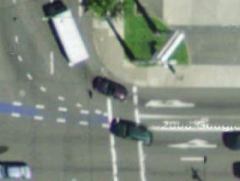
The current right/right-thru configuration is universally recognized as dangerous and unacceptable. The 1999 Portland Bicycle Master Plan states that this design is to be avoided, the League of American Bicyclists opposes the configuration, former Oregon Bicycle and Pedestrian Coordinator Michael Ronkin states that it is not possible to create a safe bike lane option with this configuration, and the FHWA states that, “this situation is particularly difficult for bicyclists.” (source: FHWA).
The good news is that everyone, including the BAC and PDOT, now agrees that this facility design must go. The bad news is that the true root of the problem, the dual-right turn lane configuration, is not being questioned. This facility, and many others like it in Portland and beyond, continue to tell drivers that the world is their onramp, and continue to provide cyclist safety only secondarily to driver convenience.
Rex Burkholder, current Metro Councilor and former BTA founder, agrees. The Broadway/Williams design, he says, is stuck in a 1960s mentality that has no place in today’s city. “Those lanes exist to speed cars onto the freeway,” he says, “but right now, the onramp has ramp signals anyway, so all we’re doing is help cars speed up so they can stop. Why should we sacrifice bicyclist and pedestrian safety for a gain of two seconds?”
In 1997, the Swedish parliament adopted a policy called “Vision Zero” (PDF). Their goal was to eliminate traffic deaths. The fundamental principle is that “it can never be ethically acceptable that people are killed or seriously injured when moving within the road transport system.”
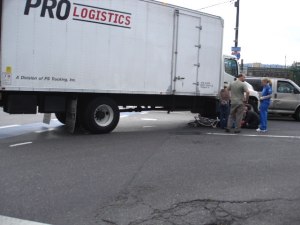
it forced PDOT to take a closer look at a solution.
(Photo: Carl Larson)
A first step to realizing this vision is to place primary responsibility for road safety on facility designers.
The success of Vision Zero is clear: in 2006, Sweden recorded 440 traffic deaths. Compare that to the US, where 42,000 people are killed every year in traffic deaths. (Even if you normalize for population size, if we had the same fatality rate, we would only see 14,500 deaths per year – in other words, if you know three people who died in traffic crashes, two of them would still be alive.)
Facilities like the dual right turn lane on NE Broadway are one of the major ways we continue to prioritize cars over people, and thus fail to learn from the stellar success of our Swedish colleagues.
PDOT is to be commended for taking on the Broadway/Williams intersection, and the signalized design they are working on may end up working well for cyclists (as long as bikes get a long enough green light). Nevertheless, it’s important to recognize that the reason we’re having to take major steps to fix this situation is that it was rotten to begin with.
Dual right turn lanes are a deliberate trade-off of pedestrian and bicycle safety for increased vehicle capacity. They demonstrate that even in Portland, we still let outdated, auto-centric thinking rule the day far too often. It’s time to do better.



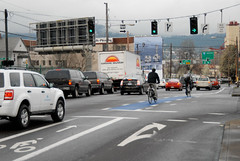
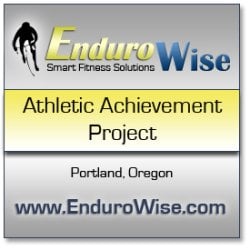


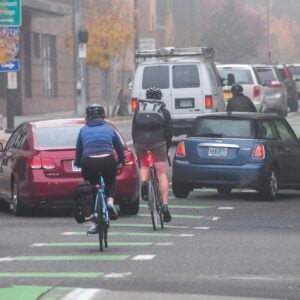
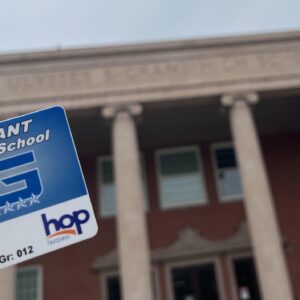
Thanks for reading.
BikePortland has served this community with independent community journalism since 2005. We rely on subscriptions from readers like you to survive. Your financial support is vital in keeping this valuable resource alive and well.
Please subscribe today to strengthen and expand our work.
Way to take on an intersection that has been our No. 1 bane for years, Jessica. Nicely written.
Excellent analysis, Jessica. That intersection scares me. But “The bad news is that the true root of the problem, the dual-right turn lane configuration, is not being questioned.” With a new mayor who supposedly prioritizes safety, why is is this configuration not being questioned? Yes, I heard Mr. Burchfield’s answer (http://bikeportland.org/2008/10/15/following-collision-pdot-puts-broadwaywilliams-back-into-play/), but it comes down to prioritizing a few seconds of convenience for cars over the lives of bicyclists. What is political leadership for if not to change those kinds of priorities? How many deaths is it going to take?
I also think we need to start banning right turns on red on streets where they endanger pedestrians and/or bicyclists. Again, it’s a matter of a few seconds delay at most. If these obstacles are so onerous to drivers, well, maybe they should consider other ways of getting around town. Like bikes or public transport, for example.
I don’t think y’all fully understand PDOT’s main point: if there was only one right turn lane there, traffic on Broadway backs up all the way back to 20th in the mornings.
While you might think “well, let that happen, I’m biking so its not a big deal”, its somewhat undesirable to be biking next to a solid block of cars, what if you had to turn left across those 4 lanes farther back? The 2 right turn lanes are needed… unfortunatley. there are plenty of good solutions that keep the 2 right lanes, we just need a good implementation of a fix
Some of that right-turning traffic is going up N Williams, but I think it’s safe to say that during peak hours, most of it is going onto I-5. It’s interesting to note that mere feet from the intersection in question, those two right turning lanes are narrowed down to one before getting on the highway (thanks to the ramp light). It’s unfortunate that narrowing can’t happen just a LITTLE bit earlier… This proves Jessica’s point, though. Well written.
The lesson here?
Move to Sweden.
Or move traffic safety to here.
Jessica,
I do agree about double-right turn lanes, that they allow the freeway to bleed into our city streets.
But in this place, even if it were one right-turn lane, I’d still want the bike-only signal! Rather than have to jangle with a long line of free-way bound cars to merge across them into the through-bike-lane.
An example of this is at NE Lloyd Blvd, eastbound, at MLK. The bike lane drops, a right-turn lane appears, and at that point bicyclists either have to merge with fast traffic or have to turn their bikes sideways to scoot between stopped cars.
Portland is going out on a limb to try this new Copenhagen-style bike design; I think it’s a big improvement and would be a big improvement even if this intersection had only one right turn lane.
Michelle
PS – In other words, I don’t think the root of the problem here is the double right turn lane. It makes things worse, but it’s not the root of the problem.
“It’s time to do better.”
Amen!
Paint the damn bike lane day glow orange already!!!
The problem here does not seem to be the double right turn lane per-se, but that some traffic engineer thought it was acceptable to situate a right turn lane to the left of a lane for straight through traffic. I’m sure it would have never occurred to that engineer to put a right turn lane to the left of a straight-through lane for automobiles. Why then did he/she believe it was OK for a bike lane? I’m not personally familiar with the intersection (I live in Seattle), but it seems laughably obvious to me that you don’t put right turning traffic to the left of straight through traffic. Why isn’t the rightmost lane for right turning vehicles (two, four, or eighteen wheels–doesn’t matter), the second lane for right either straight-through or right turning vehicles (again, whatever the number of wheels or motors)? If it is a high cycle traffic intersection, perhaps a bike box in the front of the second lane would be appropriate, but how on earth could they not forsee right hooks in the current configuration?
The new plan is nothing more than a glorified cross walk that will be promptly ignored by drivers looking to their left in order to turn right on the red light. IMHO, it is dangerous and I have no intention of ever using it. The only reason that this kind of light works at Broadway & Lovejoy is that there is no traffic coming from the left, so drivers are looking to the right (where we are) and not to the left, looking for an opening.
The only real solution is to put the bike lane to the left of both right turn lanes. Yes, it would need to cross both right lanes a block or so early. If people are uncomfortable with that, then maybe they should pick another route.
I live just off Broadway and work downtown. While my preferred transit option is cycling, I admit due to a long work schedule and too many trips to Salem, cycling has been rare in recent weeks. That said, I go pretty far out of my way to avoid this intersection when I am riding.
The intersection is far and away by most direct route but because of the lack of safety and that intersection alone, I sought out other options. Until there is improvement, I won’t ride through it.
cda,
I believe this intersection will now be “no right turn on red” for cars. With a recessed stop bar to make it less tempting.
Michelle
re comment 3, is there a source for the statement that traffic would back up to 20th is there was only one right turn lane?
I appreciate your point about the grand scheme of things, Jessica.
I also appreciate your lauding of PDOT’s efforts to figure a better way through this particularly difficult intersection.
{ believe this intersection will now be “no right turn on red” for cars}
This allready is no turn on red, and redilly enforced
Jessica;
This was fabulously written. I have rarely seen such eloquence written about transportation. “the world is their onramp” that’s a great and accurate catchphrase. My sympathy for the tragedy that your brother went through. I hope that he got through it okay.
Thanks for providing this piece.
Actually, if I remember from my time in Sweden, they don’t build freeways in cities. PERIOD. End of discussion.
Other European cities run their highways in tunnels underneath the city, and freeway/ringroad onramps are entered via tunnels in the middle of the street. This prevents ped/bike/car collisions.
I’m scared.
Jessica, good piece — ! The vicinity of freeway on / off ramps are uniformly nasty places for cyclists, and pedestrians, too.
One clarification: are you saying the existence of dual right turn lanes are the safety problem, or the inner dual-destination lane (thru-right)is the safety problem?
From my perspective, it’s the dual-destination lane that’s the problem; 2 right turn only lanes pose a difficult merge-left maneuver for cyclists, accross 2 lanes rather than the usual 1, but it’s not necessarily unsafe: the cyclist can determine when it’s safe to to do this. Yes, it is indeed a very difficult maneuver in heavy traffic, but at least you the cyclist have control of when & how you do it.
It’s the dual-destination lane that IMO creates the safety problem – there’s no way for even the wary cyclist to tell whether the motorist to their left is going straight or turning across their path. And, if you believe the absence of a driver’s turn signal means someone’s not going to turn, well, good luck to you out there…
It’s really just a slightly different version of that old reviled right hook problem – though it’s probably worse than many, since the volume of traffic turning right from that inside lane is so high, and the design is so out of the ordibnary that cyclists & drivers alike may not recognize it as a conflict.
I just don’t feel a special signal is going to do the trick. How many cars actually pay attention to the “no turn on red” signs?
Excellent piece on a dangerous spot. I’ve gone thru the intersection many times w/o feeling endangered by cars, but I’ve been very cautious every time – making sure that I’m never side by side with a car, letting questionable cars go first, etc. I’ve also seen plenty of cyclists go through on auto-pilot (or maybe with their eyes shut tight?) and seeing them scares me to death.
As for Sweden v. US, you can’t just compare population size. How about miles driven? Speeds? Laws. Etc.
I saw a cyclist get “I didn’t see himmed” there. The car kept on going and got in line to get on the freeway. I politely informed the woman that she had hit a cyclist and she went back and exchanged information. Despite my opinion about incedents like this I bit my tongue.
My point is that I am rarely riding on that section of Broadway and I managed to witness a cyclist getting tagged there. It a dangerous intersection, but not just because of it’s design, but also because people in cars do not pay attention and look for cyclsts.
Broadway could provide a quick route into town. But I have learnt the hard way and no longer ride it west of 6th. Improving the intersection at Williams solves only one of many problems. I will continue to use the awkward and slower but safer route under the Steel. Arterial streets, bike lanes, and right turns get cyclists hit. We have two solutions: bike boulevards and taking the lane when needed. We need public education, more bike boulevards, and better ways across the river.